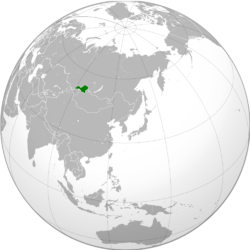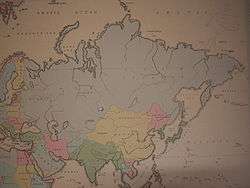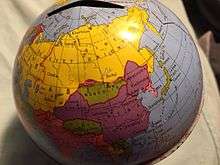Tuvan People's Republic
| Tuvan People's Republic | ||||||||||
| Tьva Arat Respuʙlik | ||||||||||
| Satellite state of the Soviet Union | ||||||||||
| ||||||||||
| ||||||||||
| Anthem Tooruktug Dolgay Tangdym | ||||||||||
 | ||||||||||
| Capital | Kyzyl | |||||||||
| Languages | ||||||||||
| Religion | ||||||||||
| Government | Marxist-Leninist single-party socialist republic | |||||||||
| Chairman | Khertek Anchimaa-Toka | |||||||||
| Prime Minister | Salchak Toka | |||||||||
| Historical era | Interwar period | |||||||||
| • | Established | August 14, 1921 | ||||||||
| • | Annexed | October 11, 1944 | ||||||||
| Area | ||||||||||
| • | 1944 | 170,500 km² (65,830 sq mi) | ||||||||
| Population | ||||||||||
| • | 1944 est. | 95,400 | ||||||||
| Density | 0.6 /km² (1.4 /sq mi) | |||||||||
| Currency | Tuvan akşa | |||||||||
| ||||||||||
| Today part of | | |||||||||

The Tuvan People's Republic (or People's Republic of Tannu Tuva; Tuvan: Tьva Arat Respuʙlik, Тыва Арат Республик, Tywa Arat Respublik, [tʰɯˈʋa aˈɾatʰ resˈpʰuplik]; 1921–44) was a partially recognized independent state in the territory of the former Tuvan protectorate of Imperial Russia also known as Uryankhaisky Krai (Russian: Урянхайский край).[lower-alpha 1]
Although formally a sovereign, independent nation[1] from 1921 to 1944, it was considered a satellite state of the Soviet Union. The Soviet Union and the Mongolian People's Republic were the only countries to recognize its independence.[2][3] It joined the Soviet Union in 1944.
Presently, the territory corresponding to that of Tannu Tuva is the non-sovereign Tuva Republic within (and a part of) the Russian Federation.
History
Before its annexation by the Russian Empire, Tuva was part of the Qing Dynasty (Tannu Uriankhai; 唐努乌梁海).
Following the Russian Revolution of 1917, communist troops took Tuva in January 1920. The chaos accompanying this era allowed the Tuvans to again proclaim their independence. On 14 August 1921, the Bolsheviks (supported by Russia) established a Tuvan People's Republic, called Tannu Tuva until 1926. Tannu refers to the Tannu-ola Mountains while Tuva is derived from the Tuvan ethnicity. The capital Khem-Beldir was eventually renamed Kyzyl ('red' in Tuvan; in Tuvan and Russian: Кызыл; in 1922–26 named "Красный", Krasnyy, 'red' in Russian). A treaty between the Soviet Union and the Mongolian People's Republic in 1926 affirmed the country’s independence. No other countries formally recognized it, although it appeared on maps and globes produced in the United States.

Tuva’s first Prime Minister was Donduk Kuular of the Tuvan People's Revolutionary Party. Kuular made Buddhism the state religion and tried to limit settlers and propaganda coming from Russia. He also tried to establish ties with Mongolia. The Soviet Union became increasingly alarmed by these initiatives and in 1929 Prime Minister Kuular was arrested and later executed in the 1929 Tuvan coup d'état. In the USSR meanwhile (in 1930) five members of the Communist University of the Toilers of the East (KUTV), the same group that executed Kuular, were appointed "commissars extraordinary" for Tuva. Staunchly loyal to Joseph Stalin's government, they purged the Tuvan People's Revolutionary Party of about a third of its members and pushed collectivisation in the traditionally nomadic cattle-breeding country.
.svg.png)
Bügüde Nayiramdaqu Tuva Arad Ulus
"Tuvan People's Republic".
The new government set about trying to destroy Buddhism and shamanism in Tuva, a policy encouraged by Stalin. Evidence of the success of these actions can be seen in the decline in the numbers of lamas in the country: in 1929 there were 25 lamaseries and about 4,000 lamas and shamans; in 1931 there was just one lamasery, 15 lamas, and approximately 725 shamans. The attempts at eradicating nomadic husbandry were more difficult. A census in 1931 showed that 82.2% of Tuvans still engaged in nomadic cattle breeding. Salchak Toka, one of the commissars extraordinary mentioned above, was made General Secretary of the Tuvan People's Revolutionary Party in 1932. He stayed in power in Tuva until his death in 1973.
It is sometimes written that Tuva entered World War II with the USSR on 22 or 25 June 1941, three days after the German attack on the Soviet Union – but the sources are dubious.[4] Nevertheless, a voluntary funding campaign in Tuva helped the Red Army in the fight against the Axis Powers. Additionally, Tuva despatched thousands of horses, skis, overcoats, and leather goods.[4] On 11 October 1944, at the request of Tuva's Small People's Khural (parliament), Tuva became a part of the Soviet Union as the Tuvan Autonomous Oblast of the Russian SFSR by the decision of Presidium of the Supreme Soviet of the USSR. The Small People's Khural formalized the annexation at its final session on 1 November 1944. Salchak Toka was given the title of First Secretary of the Tuvan Communist Party. Tuva remained an autonomous republic (Tuvan ASSR within the Russian SFSR) from 10 October 1961 until 1992. The area that was the Tuvan People's Republic is now known as Tyva Republic within the Russian Federation. Over 75% of the population of Tuva are ethnic Tuvans.
Population
| 1918 | 1931 | 1944 | 1958 | |
|---|---|---|---|---|
| Tuvans | 48,000 | 64,900 | 81,100 | 98,000 |
| Russians and other | 12,000 | 17,300 | 14,300a | 73,900 |
| Total | 60,000 | 82,200 | 95,400 | 171,900 |
a. Russian population declined due to Red Army conscription during World War II.
See also
- List of leaders of Communist Tuva
- Postage stamps and postal history of Tannu Tuva
- Tannu Uriankhai
- Tuvan akşa, the national currency.
- Tuva or Bust!, a book by Ralph Leighton about the author and his friend Richard Feynman's attempt to travel to Tuva.
Notes
- ↑ Part of the Qing Empire until its collapse in 1911.
References
- ↑ Toomas Alatalu (1992). "Tuva: a State Reawakens". Soviet Studies. 44 (5): 881–895. JSTOR 152275.
- ↑ Dallin, David J. Soviet Russia and the Far East, Yale University Press, 1948, p. 87
- ↑ Paine, S.C.M. Imperial Rivals: China, Russia, and Their Disputed Frontier, M.E. Sharpe, 1996, p. 329.
- 1 2 Denys J. Voaden: Mongolian and Tuvan aid to wartime Russia, in: M. Gervers/U. Bulag/G. Long (eds.): History and society in Central and Inner Asia, Toronto 2007, pp. 273–277 (here: p. 276).
- ↑ (Russian) V. A. Grebneva, "Geography of Tuva", Kyzyl, 1968.
External links
| Wikimedia Commons has media related to Tuvinian People's Republic. |
Coordinates: 51°41′53″N 94°23′24″E / 51.698°N 94.390°E
.svg.png)
.svg.png)
